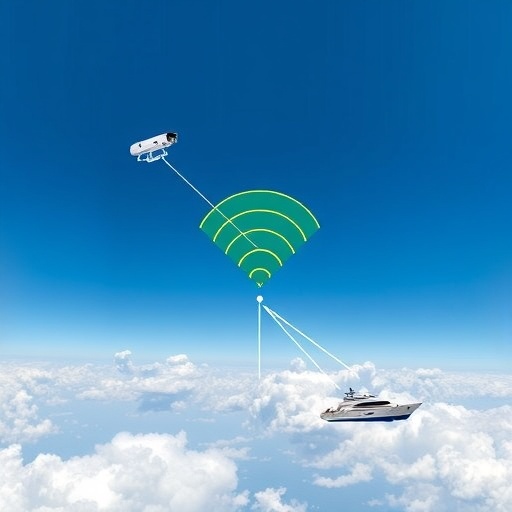A groundbreaking two-stage Track-Before-Detect (TbD) methodology has emerged, demonstrating an innovative approach to enhancing the detection of elusive moving targets by leveraging reflected Global Navigation Satellite System (GNSS) signals. Traditionally, the radar detection landscape has confronted severe limitations when it comes to discerning low-power signals, particularly in environments like the ocean, where GNSS signal reflection presents unique challenges. This new method spearheads a much-needed advancement, specifically targeting the common issue of motion model mismatch that hampers detection during prolonged integration periods.
The first phase of this pioneering approach involves the implementation of Long-Time Hybrid Integration (LTHI), which systematically corrects range and Doppler migratory effects. By concentrating the energy of the target within individual scans, the accuracy and inevitability of detection improve exponentially. This phase is crucial as it lays the foundation for subsequent analysis by constructing pivotal range-Doppler maps that reflect the corrected target data, thus maximizing the efficacy of energy detection and reducing unwanted noise.
Transitioning into the second phase, the system forsakes traditional high-threshold detection protocols. Instead, it employs a low-threshold approach to extract candidate plots, facilitating a recursive association across multiple scans based on defined kinematic constraints. This methodology fosters a synergy between detected plots across temporal dimensions, underscoring the dynamic interaction between target movement and signal processing that characterizes modern GNSS-R applications.
This technique exhibits a critical innovation by leveraging the collective properties of range-Doppler maps to narrow down plot associations intelligently. This strategic narrowing is instrumental not only in refining detection accuracy but also in significantly lessening the computational load ordinarily encountered in these types of processes. Through this refinement, the new TbD method manages to maintain high detection performance metrics, with Root Mean Square Error (RMSE) values clocking in under 4 meters for range, 0.15 Hz for Doppler, and 0.045 Hz/s for Doppler Frequency Rate, all while achieving a nearly 50% reduction in processing time in certain scenarios.
Highlighting the robustness of this new detection method, practitioners are thrilled by its capacity to uncover and track multiple targets. Experiments and simulations demonstrated the feasibility of detecting three simultaneous targets, a critical feature for real-time applications such as maritime security operations and search and rescue missions across vast stretches of open water. The implications of such an advancement are monumental, especially considering the increasing necessity for sophisticated surveillance and monitoring in locations where standard radar coverage is sparse.
The impact of this research, conducted by a collaborative team from Hohai University and The Hong Kong Polytechnic University, resonates beyond theoretical frameworks, demonstrating tangible applications in pressing real-world contexts. By harnessing and optimizing existing GNSS infrastructure for detection purposes, the proposed method stands to dramatically reduce operational costs while fostering increased accessibility—paramount factors for effective maritime domain awareness.
Experts laud this innovative work as a significant leap in passive radar technology. By intelligently utilizing the nuances of signal behavior and eliminating the constraints imposed by conventional detection methods, this improved two-stage TbD framework exemplifies a forward-thinking approach. The promising results accentuate its potential implementation in real-time scenarios where environmental conditions are challenging and operational effectiveness is non-negotiable.
The future of GNSS-R detection technologies seems vibrant. There is immense potential for ensuing research to combine target detection with comprehensive metrics including localization and velocity estimation across multiple GNSS satellite platforms. Such an integration could create a more holistic maritime situational awareness construct, thereby reinforcing the capacity for surveillance and navigation in remote or densely trafficked waterways.
As researchers continue to push the boundaries in this realm, it will be crucial to maintain the momentum of refining detection techniques while also paving the way for practical applications. The overarching goal remains clear: to maximize the capabilities of GNSS technologies, therefore promoting safer and more efficient navigation practices across a variety of sectors particularly in maritime operations.
The ramifications of this innovative TbD method extend far beyond the realm of academic discovery. The ability to effectively detect elusive moving targets using reflected signals challenges the traditional foundations of radar technology while inviting transformative applications in areas such as environmental monitoring, traffic surveillance, and disaster management. The anticipated advancements promise to redefine operational capabilities in sectors requiring precision and responsive action.
Overall, this work not only exemplifies a technological triumph but also embodies a significant contribution towards addressing the complex demands of modern surveillance and remote sensing. The evolution of GNSS-R methodologies will indubitably play a pivotal role in the ongoing quest for enhanced maritime security and awareness—a crucial necessity in an increasingly dynamic and often unpredictable global landscape.
As this two-stage Track-Before-Detect method garners further analysis and application, the maritime community eagerly awaits the potential it holds for enriched situational awareness, operational efficiency, and the overall safety of marine navigation.
Subject of Research:
Article Title: An improved track-before-detect method for moving target detection using GNSS reflected signals
News Publication Date: 1-Sep-2025
Web References:
References: 10.1186/s43020-025-00176-7
Image Credits:




